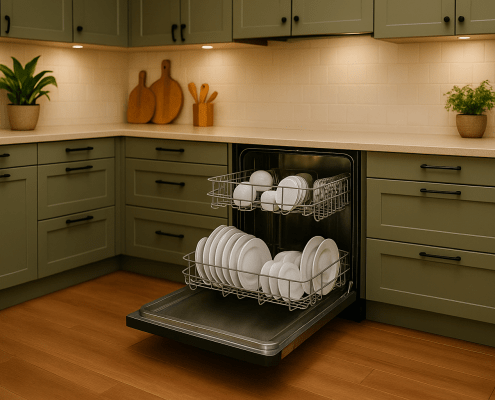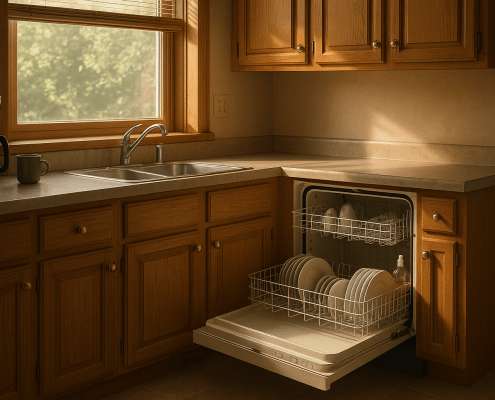How to troubleshoot and fix GE dishwasher error code F97
Steven E / Wednesday May 21, 2025
Encountering an error code on your GE dishwasher can be frustrating, but don’t worry, we’ll walk you through the process of diagnosing and resolving the error. Let’s dive in and put an end to that pesky F97 error for good.
If you find out that you need any replacement parts for your appliance while you’re troubleshooting, you can enter your model number at AppliancePartsPros.com to order them. Most orders arrive in just two business days, and we have thousands of free guides to show you how to install your new parts.
The information in this article may not apply to your specific appliance model. We recommend consulting your manufacturer’s documentation or contact us with any questions.
What the error code means
The F97 fault indicates the main control board is not receiving confirmation that the heating element is functioning properly during operation.
GE dishwashers use a dual voltage heating element to heat the wash water and air during dry cycles. This heating element is mounted underneath the dishwasher tub.
During wash cycles, it receives 120VAC power and heats water for cleansing and sanitizing dishes. The heating element reaches temperatures exceeding 150°F.
For heated dry cycles, the heating element operates at a lower 75VAC. This lessens evaporation from the residual hot rinse water while providing heat for active drying.
A thermistor mounted on the heating element monitors wash water temperatures. It provides accurate feedback on the temperature of the board that enables it to heat and cool properly.
Safety precautions
When working on any appliance, remember to keep safety first. Here are some tips to keep in mind:
- Always power off and unplug your appliance or switch off the circuit breaker before attempting any maintenance or replacement work. This keeps you safe by preventing any risk of injury from electric shock.
- Wear insulated work gloves to protect your hands from sharp metal parts, pinching hazards and debris.
- Take your time and don’t rush while working to prevent accidents and personal injuries.
- Work in a well-lit area so you can clearly see and access the interior parts.
- Clear your workspace of clutter and other obstacles. Keep children and pets away from the work area.
- Never work on internal parts with bare wet hands. Make sure the work area is completely dry.
- Check your user manual to see if there are specific installation or safety instructions for your part or appliance.
- Be gentle when handling or removing parts. Excessive force might damage the appliance or cause injury.
- Wear safety glasses when working with chemicals, dust or cleaning large debris to prevent injury.
- If the appliance has recently been used, give it plenty of time for any heating parts to cool down before working on it.
- Take pictures or make a note of wiring terminals or other connections before disconnecting to prevent any problems with reassembly.
- When working with wires, avoid touching any exposed wires or terminals. If you need to touch a wire, use a non-conductive tool or wear insulating gloves to prevent electrical shock.
Troubleshooting steps
Check the heating element
- Locate the heating element, which is a cylindrical calrod element mounted underneath the dishwasher tub.
- Visually inspect the heating element for any signs of damage, cracks, or burnout.
- Use a multimeter to test the continuity of the heating element. With the dishwasher unplugged, test the resistance across the terminals of the heating element. The expected resistance should be around 10-20 ohms.
- If the heating element is faulty or has no continuity, it will need to be replaced.
Check the thermistor
- The thermistor is a temperature sensor mounted on the heating element that provides feedback to the main control board.
- Locate the thermistor and use a multimeter to test its resistance. With the dishwasher unplugged, the resistance of the thermistor should change as the temperature changes.
- At room temperature (around 70°F), the thermistor should read between 10-20 kΩ.
- If the thermistor is faulty or the resistance is not changing as expected, it will need to be replaced.
Check the wiring and connections
- Inspect the wiring harness and connections between the heating element, thermistor, and the main control board for any signs of damage, loose connections, or corrosion.
- Use a multimeter to test the continuity of the wiring and ensure proper connectivity between the components.
- Repair or replace any damaged wiring or connectors as needed.
Check the main control board
- The F97 error code indicates an issue with the main control board’s ability to detect the proper operation of the heating element and thermistor.
- If the heating element and thermistor are functioning correctly, the main control board may be faulty and will need to be replaced.
More information
Thank you for reading! We hope you found this information useful to get your dishwasher working again.
If you have any other appliance repair needs or projects, don’t hesitate to explore our thousands of free videos and troubleshooting guides available. If you need replacement parts or some extra help, grab your model number and head over to AppliancePartsPros.com, where you can chat with a pro, order parts, read our DIY blog, and more.
Be sure to subscribe to us on YouTube and follow us on Facebook, Twitter, and Instagram!
With nearly a decade of experience in providing top-notch customer service regarding appliance parts and repair, Steven enjoys sharing practical advice, troubleshooting tips, and interesting information to help readers stay informed.





